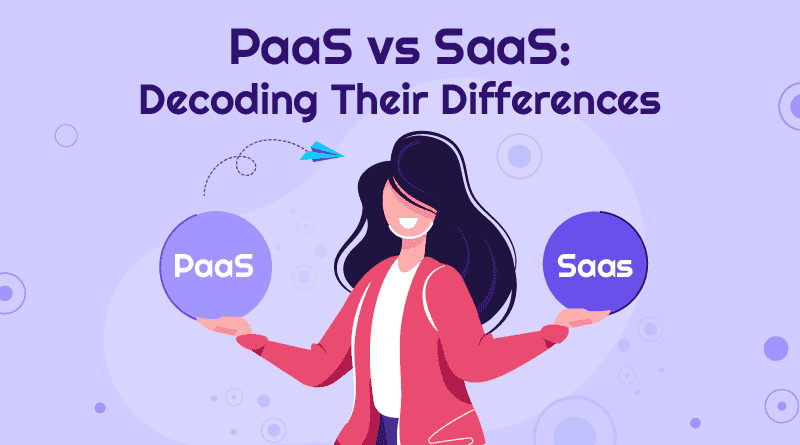What does “as a service” mean? It is simply a business model that is presented to customers internally or externally in the form of service. Thus, cloud computing delivery models like SaaS (Software as a Service) and PaaS (Platform as a Service) are two major terminologies that have created the buzz.
If you are reading about the spectrum of cloud computing, these PaaS and SaaS are two major delivery models of cloud computing. Now, what do they mean for you? Before breaking down their acronyms, let’s have an understanding of their basic definition. Also, at the end of the blog we will understand which delivery model wins the debate between PaaS vs SaaS.
Explained: PaaS
In this type of service model, the service provider offers users an access to cloud infrastructure. As a result, users have the freedom to build applications. All infrastructural resources are provided by the service provider. For example: Microsoft Azure.
Explained: SaaS
It is a software licensing model where users subscribe applications as per their usage requirements. Thus, they don’t have to install applications on individual systems. A great example of SaaS is HubSpot CRM.
How PaaS Works?
The PaaS provider offers hardware and software resources that are helpful for application development. But the hosting space of these hardware and software resources will belong to the service provider only. This is why Microsoft Azure or other PaaS service providers give you a complete cloud platform to develop, run and manage applications.
Building a highly scalable application in the PaaS delivery model is easily possible. In other delivery models, developers need to do more coding to build applications. But, with a PaaS model, coding can be done in less time, sometimes it might take days or weeks. Thus, the productivity of developers increases by reinventing the wheel.
Check Managed Cloud Hosting Plans To Scale Your Business!
The gear and software required to create and run the application are purchased and managed by teams during traditional on-premises development. In a PaaS cloud model, a third-party vendor often offers the necessary computer resources on a pay-as-you-go basis or for a set monthly cost. As a result, the PaaS expenses may be lower, however this is not always the case.
Related: Platform as a Service (PaaS) – Democratizing Innovation And Technology
How SaaS Works?
In this cloud computing delivery model, there will be a cloud provider which will distribute the software application across different systems. It means, the software provider will either contract a cloud provider to host the program in the provider’s data centre or an ISV may host the application and accompanying data on its own servers, databases, networking, and computing resources. Any device with a network connection will be able to access the program. Web browsers are often used to access SaaS apps.
SaaS (software as a service) software is a crucial component of cloud computing systems. SaaS enables consumers to subscribe to software or an application, saving them the inconvenience of having to buy it outright. Such software is also available for rental through SaaS apps.
Through SaaS technology, installation and maintenance costs are automatically lowered. On behalf of the business, SaaS providers install, run, and support particular software or applications.
Software as a service (SaaS) is a methodology for distributing software that makes all major types of applications available online, including infrastructure as a service (IaaS), platform as a service (PaaS), and software as a service (SaaS).
Related: 5 Tips To Choose The Best SaaS Hosting
PaaS vs SaaS: Characteristics of PaaS
A PaaS platform’s functionality can differ from vendor to vendor. But all PaaS products have the following key traits:
- Customers receive the servers, networks, and storage that make up the underlying cloud architecture (PaaS infrastructure);
- Middleware services such as databases, messaging services, load balancers, firewalls, cache storage, data analysis tools, etc.; these functions are especially helpful when programmers create extensive programs that use numerous middleware services;
- Support for numerous technologies, including programming languages, is offered by many PaaS providers. The support often includes the most well-liked technologies, such as Ruby, PHP, Python, Node.js, PostgreSQL, and MongoDB.
SaaS Characteristics
- SaaS is highly customizable and can be tailored to match any organization’s particular needs without significantly altering its current infrastructure. Even routine SaaS upgrades can be carried out in the background without compromising the data used by the customers.
- Built on a Multitenant Architecture: A Multitenant Architecture is a centralised, shared infrastructure and code that is used by all users and applications. As a result, SaaS providers can innovate more quickly and free up their time from having to maintain numerous out-of-date code versions.
- Better Access: SaaS provides access to data that is superior to that of any other network. This makes it is possible for all users to have secure access to the same information, which facilitates collaboration.
The debate of PaaS vs SaaS is unending because developers choose these models as per their requirement. If developers do not haveenough technical expertise to build applications, they must prefer the SaaS model. The PaaS model works for those developers who have knowledge about software and applications.







